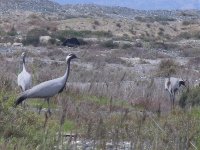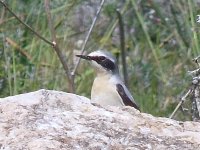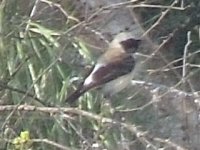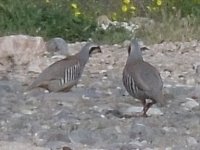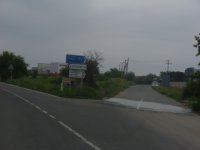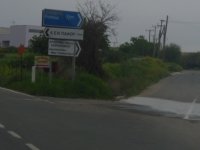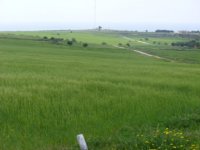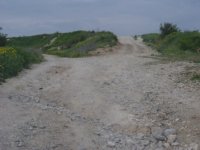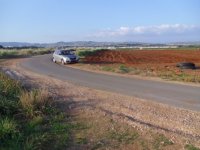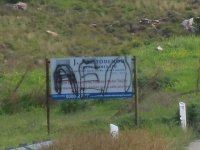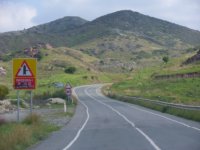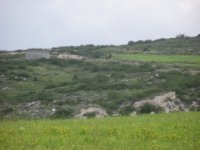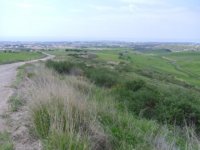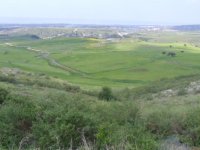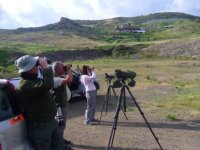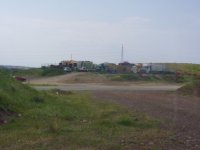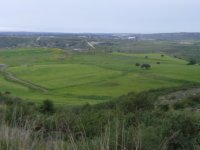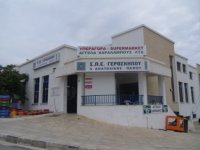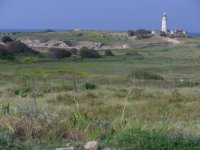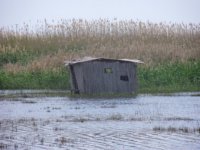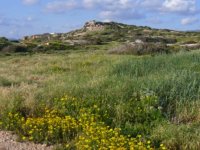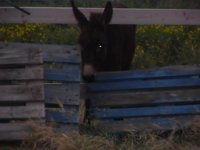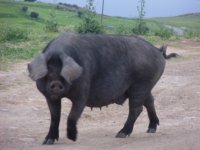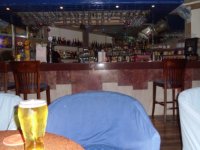wolfbirder
Well-known member
BACKGROUND
Although I nearly decided against returning here due to the amount of migrants reaching their ultimate fate on this vastly over-developed and increasingly unattractive island (sorry thats my personal view), I made the booking some months back, with outlandish targets such as Blue-cheeked Bee-eater and Cinereous Bunting in mind, and critically for me I was determined to see a male Pallid Harrier. I have seen a few juvs/female Pallids, but me and a male of this species have a chequered history. Last spring I reported on this sub-forum regards my trip 6 - 10th April, how I spent 2 days at Cape Greco, and 2 at Paphos hoping to see one. Whilst at the former I popped over to an inland reservoir only to be later told I had missed one, there was another the day I drove to Paphos for the second half of my trip, there had also been one at Paphos Headland as I drove from Cape Greco to Paphos, and to really rub it in, a Geordie birder advised me I had just missed a male passing through the headland as I went to get something from my car. More of him later! So wherever I go, they seem to elude me.
LOGISTICS
Overall the 4 days cost me £300 approximately - comprising £175 return flights from Brum - Paphos with Monarch, £46 car hire with Economy Car Hire (via SIXT) with no excess fee, and a wonderful googled offer of £70 for 4 nights half board at the Hotel Nereus in Paphos, which was just a ten minute walk from the headland. Although full of British grey-haired sub-species, rather than the hairless form like me :-C, it was absolutely ideal. This time of year must produce many similar offers. Beds were hard but they produced a roll-up matress to make it more comfortable. Rooms were fine and the hotel very clean, food was 'ok' (I do not imply it was bad here). What can you expect for £17.50 per night?
BIRDING SETBACKS
I was soon to discover that groundsmen at the 'headland' had been extremely over-zealous regards the use of crop sprayer and strimmers, cutting down long areas of grass, spraying poppy fields, and even decimating several key bushes that attract Nightingales, in the main area of the site.
Secondly, rainfall had been so heavy this winter that Asprokremnos Dam had burst its banks, washing away the "Aspro Pools". It may well become more productive for crakes as spring evolves.
Thirdly, Paphos sewage works had concreted over the sludge mounds at the back of the works, that last year had been so productive for waders, pipits and wagtails. I suspect this change is terminal !
BIRDING AREAS
Birding was slow, spring migration had not really kicked in, though I was aware when choosing these dates to connect with specific species that it may be a few weeks until Wrynecks, shrikes, Bee-eaters, flycatchers, Rollers, RF Falcons, Lesser Kestrels moved through in numbers. It is worth checking the Cyprus Birdline number for updates, I am not sure about cost though. Ring 0035725934076. Also can check recent sightings under Birdwatching sub-section on www.birdlifecyprus.org. Though this is only updated every few days. Word of mouth of course is often best, and you will bump into regulars on the Headland and elsewhere. I met some great people, such as Mick Sharp from Derby, and Ben? from Lowestoft (on my last day), also March regulars Neil, his brother and wife, and finally a couple who were Wolverhampton ex-pats. All smashing folk who tried to help and share information. These people helped make my short break very enjoyable.
I would point out that birding quality and quantity can vary immensely and daily anywhere, such is the unpredictability of migration. Birds seen sometimes are just moving through.
Hence, like most Paphos-based birders, I decided to visit the following sites on a rotational basis, repeatedly checking those out that are all accessable easily off the old 'main' B6 road that runs from Paphos to Limmasol : -
1) PAPHOS HEADLAND ARCHEOLOGICAL SITE - Each early morning I decided to concentrate on the 'headland' (the archeological site), which was surprisingly open at 7.45am on my first morning, where I purchased my 3.50 euro ticket. You should retain it, though no one ever checked when I accessed the site on subsequent mornings through the holes in the fence. Birders here have always done this without any problem. In last years report I highlighted and photographed this hole by a locked turnstile, at the end of a small cul-de-sac with good parking for 3-4 cars. There was still a widely used hole here. To access the cul-de-sac simply leave the official free car park at the archeological site, skirt to the left rather than back into central Paphos, and take the first left turn. Drive a hundred metres or so to the end of the cul-de-sac and park up. Despite areas of vegetation being decimated it was still worth visiting, and holds warblers, larks, wagtails, pipits, as well a shrikes and wrynecks, and always have an eye skyward for vis-mig including raptor passage.
On my final morning, I arrived a little later than usual having packed and checked out. On arrival I was welcomed by that same Geordie guy from a year ago - and guess what - he cheerfully told me that I had missed 2 male Pallid Harriers! I could have cried. This fixation was getting to me now! I stumbled across the headland in a Victor Meldrew manner, frequently saying "I don't believe it", though there were expletives certainly added!
2) EZOUSAS OUTFLOW POOLS (ACHELEIA) AND PAPHOS SEWAGE WORKS FIELDS - these two sites lie immediately next to each other. To access this site, very approximately about 10kms from Paphos along the B6, as you enter the village of Acheleia, & immediately as you cross the river on the B6, with white railings on the bridge, take a sharp turn right 'immediately' after these railings, and follow this road alongside the river for about two miles, even keeping on it as it becomes a rougher track towards the end (as opposed to staying on the tarmacced road that eventually swings inland). Then take the "2nd" short track on your left (both are within 20-30 metres of each other), as the 2nd one goes slightly uphill. Park at the top as you can then see 3 small adjacent pools below, from this elevated point. Park to the side ensuring any locals that might come along can pass. Scour the edges for crakes and herons.
3) ANARITA PARK - this 'not-well documented' area was repeatedly visited, though in no shape or form is it a park. I suppose it may be more difficult in wet conditions. Gosney and other book guides, as well as a good map, are useful for all these areas highlighted, but Anarita Park is not well described in my opinion. This area is potentially very good for raptor passage, and for hirundines and passerines. It is not signposted so directions are important. I will try to provide detail here therefore, so future visitors can navigate around.
You can access it at either end (from just past Agia Varvara or Anarita), but it is important that you initially access it from the Agia Varvara end, as it is more confusing accessing it from Anarita village. The track runs for about two miles in total. So, to get there, instead of taking the left turn for 'Anarita' a few km's further along the B6, turn left (inland) where you see a sign for 'Agia Varvara'. You soon go under the main A6 dual carriageway (that in effect runs parallel to the B6 all the way from Paphos to Limmasol). As you pass under the A6 check your km counter, as 2.9 kms later you take a rough track to your right. You will have passed Agia Varvara village to your left on this road (not taking the turn to the village itself & staying on the main road), and also the signposted Loukaides Chicken Farm (good apparently here for Rollers, RF Falcons on wires in May), then just before the road rises into the hills, there is a refuse lorry depot or compound to your right. A few hundred metres after this, there is the sharp turn right onto the rough track exactly 2.9kms after passing under the A6. It is perfectly driveable in a car, but as always take care to avoid small boulders and crevices in the tracks. Especially if your car has a low trajectory and underbody. With care though, you should certainly have no problem on these tracks.
The track initially bends upwards and to the left, passed a half-built villa, and then down to the right less than a km after entering Anarita Park. At the base of this section is a good 'small plateau' to the immediate left of the track, with scrub, rocky terrain and hard-to-see remnants of a pool (will probably dry out soon). This area proved good for wheatear species and Cretz Buntings in the later afternoon sun, and had held a Rock Thrush a few days earlier. Blue Rock Thrush was present. A dead end track at this small plateau leads up hill for a hundred metres only.
The next bit is important. Immediately after the 'small plateau' you continue and come to a junction offering 3 tracks. The right hand one leads back to the main road via Loukaides Chicken Farm so is not really what you want. The middle one takes you low through the valley, so I would strongly recommend taking the LEFT HAND track uphill here. After a hundred or so metres it again splits (left also takes you back to a main road) so follow it to the right, onwards and upwards. It is then plain sailing as it eventually leads to Anarita village. But inbetween, this section of elevated track potentially offers great birding, with views down to the right to the 'stretching' cereal fields (raptor passage), and also a great area of scrub just below the track, for those sought-after warblers. There is a gulley that overlooks a small goat holding here that produced Orphean (not for me), Subalpine, Spectacled, and Ruppells Warblers & Great Spotted Cuckoo. There is the first of two concrete water tanks just after this gulley, and the scrub all around here is potentially excellent for vis mig and resident warblers. The views are superb over the general area, so keep an eye skyward at all times for passing raptors, which can be above or beneath you. At 4.25pm on my final day a superb, very pale adult male Pallid Harrier drifted past, and I shouted with delight. Thankfully there was no one around. At last I had connected with one of my favourate birds! Relief and joy filled me with equal measure.
As I say you can alternatively access these tracks from nearby Anarita, but for the first-time visitor it is very difficult to get your bearings at that end, making it very hard to locate the access track which initially runs out through the village for haldf a mile.
4) ANARITA RADAR MAST AND ASPROKREMNOS DAM - this area may be referred to an a continuation of Anarita Park by some, or simply as a part of Asprokremnos Dam by others, but it is seperate from both and lies just on the 'other' (eastern) side of Anarita village, so is accessable by turning left and continuing inland once you hit the zig zag village centre from Anarita Park, or alternatively by taking the turn off the main B6 where it is signposted 'Anarita', and then driving up through the 'zig-zag' village road, and then a km later turning right when you see the radar mast, or shortly after another right turn where you see a sign for 'Asprokremnos Water Treatment Works'. DO NOT take the lane 'past' and through the water works, even if enticed by signs for 'Phinikas' (legendary Finsch's Wheatear site). This particular track is incredibly rough as it runs downhill towards the reservoir, and comes to a dead end at the water's edge. I reckon cars with lower trajectory would come unstuck here! I found it very hard to turn around and som eof the ruts in the road were potentially damaging to car underbodies.
However, the general area is great, with driveable tracks criss-crossing each other, and by keeping the 'towering' radar mast in view, you keep your bearings. The whole area comprises cereal fields and scattered trees, favoured by harriers, larks, Chukars, and by the Radar Mast perimeter fence by Spectacled Warblers and sometimes wheatears. We also had Bonelli's Eagles here on one occasion, though repeat visits highlighted that sometimes it appeared to be fairly dead.
The track alongside the Radar Mast compound does lead to Asprokremnos Dam just a km away, but it is a bit rough in sections, and you may prefer therefore to return to the main B6 road via Anarita, and then take the inland turn off the B6 where the dam is signposted. I took the short cut each time, following the tracks though a bit dodgy and deeply rutted in parts.
Asprokremnos Dam is currently not very productive as Aspro Pools have been washed away below the dam. They may dry out fairly quickly though, and again become productive to crakes. The reservoir itself rarely holds much except gulls. But just before you cross the bridge, turn left into a small wooded area known as "AMENITIES AREA". Park at the end and check out the trees and scrub at the 'very' end, as that part often holds the best birds. It can be good for flycatchers, Wryneck and warblers. I had female Eastern Orphean, Cyprus, Ruppell's, and several Sardinian Warblers over a few visits.
5) MANDRIA FIELDS - this is the next site accessed off the main B6, this time towards the coast. I always find 'pretty' Mandria village hard to navigate, but by following signs for the 'beach' you will access the fields that includes 'lark corner', and also the beach that can hold Greater Sand Plover. The area undoubtedly holds quality birds though I found it unproductive over several visits. The larks can often be hidden away. Harriers are often reported here but I saw none at all here over several visits.
OTHER AREAS VISITED FROM PAPHOS INCLUDED : -
AKAMAS PENINSULA - An hour's drive on the B7 from Paphos, via Polis. THE BATHS OF APHRODITE CARAVAN PARK only produced a couple of Sardinian Warblers, as did nearby SMIYIES AMENITIES SITE, though both warranted further inspection. The former site especially, is well known for holding flycatchers and warblers at good migration times.
CAPE DRAPURNUM - a brief evening visit to this small and easily birded site produced a number of Short-toed Larks, and Sardinian Warblers in the hillside scrub, but nothing rarer this time. Again, it has a good reputation for holding good birds.
AKROTIRI SALT LAKE, GRAVEL PITS AND PLAINS, INCLUDING PHASSOURI REEDBED - this site is legendary, and although on the edge of Limmassol which is about an hour away from Paphos via the A6 dual carriageway, and then linking belatedly to the B6, it is very worthwhile. Study the map to get here.
From memory, Phassouri Reedbed is found by turning right at a signpost for a cat sanctuary from the main Akrotiri road, and then right again soon after, along a narrow-looking, windy lane that soon runs alongside the reedbed edge. There is an obvious area to park up, overlooking a small pool with a 'currently' semi-submerged hide. Waders and wildfowl are found here, including one or two Fudge Ducks. I found a Marsh Sandpiper amongst more routine species. Views here can be excellent. Rejoin the lane and about a mile later turn left onto a rough stoney track that leads out across the extensive gravel pits, with the radar masts in the distance. It can appear birdless but it can hold gems such as a very recent Sociable Plover & 2 Cream-coloured Coursers, and delightfully 3 'straggling' adult Demoiselle Cranes, that I eventually found by taking tracks to the right of the radar masts. Views were enjoyed down to ten metres! Beware, several birders have been moved on by over-zealous British army chaps here. And also beware of lethal mosquitos here!
Photos hopefully to follow regards these sites, once my suitcase appears, having not arrived at Birmingham on my return home two days ago.
THE BIRDS - sorry in no order...............
Demoiselle Cranes - 3 superb adults seen closely at Akrotiri Salt Plain
Pallid Harrier - 4 adult females seen, 2 at Anarita Radar Mast & 2 at Anarita Park. Superb male 'finally' at Anarita Park!
Bonelli's Eagle - a pair seen at Anarita Radar Mast, by Asprokremnos Dam.
Long-Legged Buzzard - singles at Anarita Park and Anarita Radar Mast
Griffon Vulture - single drifting east of Pissouri
Marsh Harrier - 6 birds - singles at Ezousas, Phassouri Reedbeds, 2 at Anarita Radar Mast, 2 at Anarita Park
Common Buzzard - 2 east of Pissouri, 1 at Ezousas overflow Pools
Kestrel - widespread. Approx 60 seen
Marsh Sandpiper - single at Phassouri Reedbeds
Little Crake - 2 adults and female seen at Ezousas overflow pools each visit at back of pools on waters edge
Eastern Orphean Warbler - female of presumed eastern race seen at amenities area coppice at Asprokremnos Dam
Eastern Subalpine Warbler - fine male seen at Anarita Park, in gulley from top track
Ruppell's Warbler -3 at Paphos Headland, 1 at Asprokremnos Dam, 2 at Anarita Park
Spectacled Warbler - approx 20 birds seen - mainly at Anarita Park and Anarita Radar Mast
Great Spotted Cuckoo - approx 8 birds seen, pairs at Anarita Park and Anarita Radar Mast quite regularly
Glossy Ibis - single at Phassouri Reedbed, small flocks past at Ezousas overflow pools
Greater Flamingo - around 300 at Akrotiri Salpans but quite distant
Squacco Heron - juvenile seen at Ezousas overflow pools
Purple Heron - 3 fine adults seen at Ezousas overflow pools, single at Bishop's Pool
Grey Heron - 2 singles at Asprokremnos Dam
Night Heron - groups of 6 and 3 passing over Paphos Headland
Tawny Pipit -about 12 birds seen, especially at Anarita Park
Meadow Pipit - about 20 birds seen, such as at Paphos sewage works fields
Short-Toed Lark - small groups of 6-12 birds at Paphos Headland, Cape Drapurnum, and Mandria
Hoopoe - approx 5 birds seen
Black-Eared Wheatear - approx 10 seen, 8 eastern and 2 western, at Anarita Park and Anarita Radar Mast
Cyprus Pied Wheatear - approx 10 birds seen such as at Anarita Radar Mast and Anarita Park
Northern Wheatear - approx 15 birds seen such as at Paphos headland & Anarita Park
Cyprus Warbler - upto 8 seen such as at Asprokremnos Dam and Anarita Park top track
Sardinian Warbler - at least 30 birds seen but more widespread
Black-Headed Wagtail - at least 10 seen at Paphos Sewage works fields
Grey-Headed Wagtail - single male seen at Paphos Sewage works fields
Blue-Headed Wagtail - approx 30 birds seen at Paphos Sewage works fields
White Wagtail - at least 60 seen at Paphos Sewage works fields
Fan-Tailed Warbler - approx 5 seen such as at Anarita Radar Mast, but more widespread
Blue Rock Thrush - pair seen at Anarita Park
Black Francolin - 2 males and a female seen at Mandria
Chukar - at least 30 seen, such as at Anarita Radar Mast and Anarita Park
Spur-Winged Plover - 4 seen at Paphos Sewage Works fields
Great White Egret - single bird at Akrotiri Salt Plains
Cattle Egret - 2 birds at Phassouri Reedbeds
Little Egret - 3 birds at Ezousas overflow pools
Spanish Sparrow - approx 200 birds seen east of Pissouri
Red-Rumped Swallow - about 15 birds seen at Paphos Headland
Swallow - approx 300 birds seen
House Martin - several birds seen at Paphos Headland
Common Swift - approx 400 seen
Pallid Swift - approx 100 seen at Anarita Park & Paphos Headland
Ferruginous Duck - a pair and a drake at Phassouri Reedbeds
Spotted Redshank - single juvenile at Phassouri Reedbeds
Green Sandpiper -3 at Phassouri Reedbeds
Wood Sandpiper -single bird at Phassouri Reedbeds
Ruff - 4 birds at Phassouri Reedbeds
Cetti's Warbler - single bird at Bishop's Pool (many others heard)
Black Redstart - 2 juvs at Paphos Headland
Lesser Whitethroat - approx 15 seen at Anarita Park & Paphos Headland
Blackcap - 6 birds seen at Paphos Headland and Asprokremnos Dam amenities area
Chiffchaff - approx 15 seen at Paphos Headland and Asprokremnos Dam amenities area
Hooded Crow - widespread. Approx 500 seen
Jackdaw - approx 100 seen in small groups, including a few eastern birds, such as at Cape Drapurnum
Magpie - approx 100 seen, widespread
Greenfinch - approx 25 seen
Goldfinch - approx 20 seen
Linnet - approx 40 seen
House Sparrow - widespread
Corn Bunting - approx 150 seen, common on hillsides such as at Anarita Park. Widespread.
Collared Dove - common in villages
Wood Pigeon - fairly common such as at Mandria
Yellow-Legged Gull - fairly common around coast
Shag - group of 12 over Asprokremnos Dam
Whinchat - 5 birds seen at Paphos Headland
Stonechat - 5 birds seen around Anarita Radar Mast
Great Tit - approx 15 seen, especially at Paphos Headland
Crested Lark - approx 500 seen. Widespread
Little Ringed Plover - 6 at Phassouri Reedbeds
Coot - 30 at Phassouri Reedbeds
Moorhen - around 50 seen, such as at Phassouri Reedbeds and Ezousas overflow pools
Little Grebe - several seen at Bishops Pool and Ezousas overflow pools
Although I nearly decided against returning here due to the amount of migrants reaching their ultimate fate on this vastly over-developed and increasingly unattractive island (sorry thats my personal view), I made the booking some months back, with outlandish targets such as Blue-cheeked Bee-eater and Cinereous Bunting in mind, and critically for me I was determined to see a male Pallid Harrier. I have seen a few juvs/female Pallids, but me and a male of this species have a chequered history. Last spring I reported on this sub-forum regards my trip 6 - 10th April, how I spent 2 days at Cape Greco, and 2 at Paphos hoping to see one. Whilst at the former I popped over to an inland reservoir only to be later told I had missed one, there was another the day I drove to Paphos for the second half of my trip, there had also been one at Paphos Headland as I drove from Cape Greco to Paphos, and to really rub it in, a Geordie birder advised me I had just missed a male passing through the headland as I went to get something from my car. More of him later! So wherever I go, they seem to elude me.
LOGISTICS
Overall the 4 days cost me £300 approximately - comprising £175 return flights from Brum - Paphos with Monarch, £46 car hire with Economy Car Hire (via SIXT) with no excess fee, and a wonderful googled offer of £70 for 4 nights half board at the Hotel Nereus in Paphos, which was just a ten minute walk from the headland. Although full of British grey-haired sub-species, rather than the hairless form like me :-C, it was absolutely ideal. This time of year must produce many similar offers. Beds were hard but they produced a roll-up matress to make it more comfortable. Rooms were fine and the hotel very clean, food was 'ok' (I do not imply it was bad here). What can you expect for £17.50 per night?
BIRDING SETBACKS
I was soon to discover that groundsmen at the 'headland' had been extremely over-zealous regards the use of crop sprayer and strimmers, cutting down long areas of grass, spraying poppy fields, and even decimating several key bushes that attract Nightingales, in the main area of the site.
Secondly, rainfall had been so heavy this winter that Asprokremnos Dam had burst its banks, washing away the "Aspro Pools". It may well become more productive for crakes as spring evolves.
Thirdly, Paphos sewage works had concreted over the sludge mounds at the back of the works, that last year had been so productive for waders, pipits and wagtails. I suspect this change is terminal !
BIRDING AREAS
Birding was slow, spring migration had not really kicked in, though I was aware when choosing these dates to connect with specific species that it may be a few weeks until Wrynecks, shrikes, Bee-eaters, flycatchers, Rollers, RF Falcons, Lesser Kestrels moved through in numbers. It is worth checking the Cyprus Birdline number for updates, I am not sure about cost though. Ring 0035725934076. Also can check recent sightings under Birdwatching sub-section on www.birdlifecyprus.org. Though this is only updated every few days. Word of mouth of course is often best, and you will bump into regulars on the Headland and elsewhere. I met some great people, such as Mick Sharp from Derby, and Ben? from Lowestoft (on my last day), also March regulars Neil, his brother and wife, and finally a couple who were Wolverhampton ex-pats. All smashing folk who tried to help and share information. These people helped make my short break very enjoyable.
I would point out that birding quality and quantity can vary immensely and daily anywhere, such is the unpredictability of migration. Birds seen sometimes are just moving through.
Hence, like most Paphos-based birders, I decided to visit the following sites on a rotational basis, repeatedly checking those out that are all accessable easily off the old 'main' B6 road that runs from Paphos to Limmasol : -
1) PAPHOS HEADLAND ARCHEOLOGICAL SITE - Each early morning I decided to concentrate on the 'headland' (the archeological site), which was surprisingly open at 7.45am on my first morning, where I purchased my 3.50 euro ticket. You should retain it, though no one ever checked when I accessed the site on subsequent mornings through the holes in the fence. Birders here have always done this without any problem. In last years report I highlighted and photographed this hole by a locked turnstile, at the end of a small cul-de-sac with good parking for 3-4 cars. There was still a widely used hole here. To access the cul-de-sac simply leave the official free car park at the archeological site, skirt to the left rather than back into central Paphos, and take the first left turn. Drive a hundred metres or so to the end of the cul-de-sac and park up. Despite areas of vegetation being decimated it was still worth visiting, and holds warblers, larks, wagtails, pipits, as well a shrikes and wrynecks, and always have an eye skyward for vis-mig including raptor passage.
On my final morning, I arrived a little later than usual having packed and checked out. On arrival I was welcomed by that same Geordie guy from a year ago - and guess what - he cheerfully told me that I had missed 2 male Pallid Harriers! I could have cried. This fixation was getting to me now! I stumbled across the headland in a Victor Meldrew manner, frequently saying "I don't believe it", though there were expletives certainly added!
2) EZOUSAS OUTFLOW POOLS (ACHELEIA) AND PAPHOS SEWAGE WORKS FIELDS - these two sites lie immediately next to each other. To access this site, very approximately about 10kms from Paphos along the B6, as you enter the village of Acheleia, & immediately as you cross the river on the B6, with white railings on the bridge, take a sharp turn right 'immediately' after these railings, and follow this road alongside the river for about two miles, even keeping on it as it becomes a rougher track towards the end (as opposed to staying on the tarmacced road that eventually swings inland). Then take the "2nd" short track on your left (both are within 20-30 metres of each other), as the 2nd one goes slightly uphill. Park at the top as you can then see 3 small adjacent pools below, from this elevated point. Park to the side ensuring any locals that might come along can pass. Scour the edges for crakes and herons.
3) ANARITA PARK - this 'not-well documented' area was repeatedly visited, though in no shape or form is it a park. I suppose it may be more difficult in wet conditions. Gosney and other book guides, as well as a good map, are useful for all these areas highlighted, but Anarita Park is not well described in my opinion. This area is potentially very good for raptor passage, and for hirundines and passerines. It is not signposted so directions are important. I will try to provide detail here therefore, so future visitors can navigate around.
You can access it at either end (from just past Agia Varvara or Anarita), but it is important that you initially access it from the Agia Varvara end, as it is more confusing accessing it from Anarita village. The track runs for about two miles in total. So, to get there, instead of taking the left turn for 'Anarita' a few km's further along the B6, turn left (inland) where you see a sign for 'Agia Varvara'. You soon go under the main A6 dual carriageway (that in effect runs parallel to the B6 all the way from Paphos to Limmasol). As you pass under the A6 check your km counter, as 2.9 kms later you take a rough track to your right. You will have passed Agia Varvara village to your left on this road (not taking the turn to the village itself & staying on the main road), and also the signposted Loukaides Chicken Farm (good apparently here for Rollers, RF Falcons on wires in May), then just before the road rises into the hills, there is a refuse lorry depot or compound to your right. A few hundred metres after this, there is the sharp turn right onto the rough track exactly 2.9kms after passing under the A6. It is perfectly driveable in a car, but as always take care to avoid small boulders and crevices in the tracks. Especially if your car has a low trajectory and underbody. With care though, you should certainly have no problem on these tracks.
The track initially bends upwards and to the left, passed a half-built villa, and then down to the right less than a km after entering Anarita Park. At the base of this section is a good 'small plateau' to the immediate left of the track, with scrub, rocky terrain and hard-to-see remnants of a pool (will probably dry out soon). This area proved good for wheatear species and Cretz Buntings in the later afternoon sun, and had held a Rock Thrush a few days earlier. Blue Rock Thrush was present. A dead end track at this small plateau leads up hill for a hundred metres only.
The next bit is important. Immediately after the 'small plateau' you continue and come to a junction offering 3 tracks. The right hand one leads back to the main road via Loukaides Chicken Farm so is not really what you want. The middle one takes you low through the valley, so I would strongly recommend taking the LEFT HAND track uphill here. After a hundred or so metres it again splits (left also takes you back to a main road) so follow it to the right, onwards and upwards. It is then plain sailing as it eventually leads to Anarita village. But inbetween, this section of elevated track potentially offers great birding, with views down to the right to the 'stretching' cereal fields (raptor passage), and also a great area of scrub just below the track, for those sought-after warblers. There is a gulley that overlooks a small goat holding here that produced Orphean (not for me), Subalpine, Spectacled, and Ruppells Warblers & Great Spotted Cuckoo. There is the first of two concrete water tanks just after this gulley, and the scrub all around here is potentially excellent for vis mig and resident warblers. The views are superb over the general area, so keep an eye skyward at all times for passing raptors, which can be above or beneath you. At 4.25pm on my final day a superb, very pale adult male Pallid Harrier drifted past, and I shouted with delight. Thankfully there was no one around. At last I had connected with one of my favourate birds! Relief and joy filled me with equal measure.
As I say you can alternatively access these tracks from nearby Anarita, but for the first-time visitor it is very difficult to get your bearings at that end, making it very hard to locate the access track which initially runs out through the village for haldf a mile.
4) ANARITA RADAR MAST AND ASPROKREMNOS DAM - this area may be referred to an a continuation of Anarita Park by some, or simply as a part of Asprokremnos Dam by others, but it is seperate from both and lies just on the 'other' (eastern) side of Anarita village, so is accessable by turning left and continuing inland once you hit the zig zag village centre from Anarita Park, or alternatively by taking the turn off the main B6 where it is signposted 'Anarita', and then driving up through the 'zig-zag' village road, and then a km later turning right when you see the radar mast, or shortly after another right turn where you see a sign for 'Asprokremnos Water Treatment Works'. DO NOT take the lane 'past' and through the water works, even if enticed by signs for 'Phinikas' (legendary Finsch's Wheatear site). This particular track is incredibly rough as it runs downhill towards the reservoir, and comes to a dead end at the water's edge. I reckon cars with lower trajectory would come unstuck here! I found it very hard to turn around and som eof the ruts in the road were potentially damaging to car underbodies.
However, the general area is great, with driveable tracks criss-crossing each other, and by keeping the 'towering' radar mast in view, you keep your bearings. The whole area comprises cereal fields and scattered trees, favoured by harriers, larks, Chukars, and by the Radar Mast perimeter fence by Spectacled Warblers and sometimes wheatears. We also had Bonelli's Eagles here on one occasion, though repeat visits highlighted that sometimes it appeared to be fairly dead.
The track alongside the Radar Mast compound does lead to Asprokremnos Dam just a km away, but it is a bit rough in sections, and you may prefer therefore to return to the main B6 road via Anarita, and then take the inland turn off the B6 where the dam is signposted. I took the short cut each time, following the tracks though a bit dodgy and deeply rutted in parts.
Asprokremnos Dam is currently not very productive as Aspro Pools have been washed away below the dam. They may dry out fairly quickly though, and again become productive to crakes. The reservoir itself rarely holds much except gulls. But just before you cross the bridge, turn left into a small wooded area known as "AMENITIES AREA". Park at the end and check out the trees and scrub at the 'very' end, as that part often holds the best birds. It can be good for flycatchers, Wryneck and warblers. I had female Eastern Orphean, Cyprus, Ruppell's, and several Sardinian Warblers over a few visits.
5) MANDRIA FIELDS - this is the next site accessed off the main B6, this time towards the coast. I always find 'pretty' Mandria village hard to navigate, but by following signs for the 'beach' you will access the fields that includes 'lark corner', and also the beach that can hold Greater Sand Plover. The area undoubtedly holds quality birds though I found it unproductive over several visits. The larks can often be hidden away. Harriers are often reported here but I saw none at all here over several visits.
OTHER AREAS VISITED FROM PAPHOS INCLUDED : -
AKAMAS PENINSULA - An hour's drive on the B7 from Paphos, via Polis. THE BATHS OF APHRODITE CARAVAN PARK only produced a couple of Sardinian Warblers, as did nearby SMIYIES AMENITIES SITE, though both warranted further inspection. The former site especially, is well known for holding flycatchers and warblers at good migration times.
CAPE DRAPURNUM - a brief evening visit to this small and easily birded site produced a number of Short-toed Larks, and Sardinian Warblers in the hillside scrub, but nothing rarer this time. Again, it has a good reputation for holding good birds.
AKROTIRI SALT LAKE, GRAVEL PITS AND PLAINS, INCLUDING PHASSOURI REEDBED - this site is legendary, and although on the edge of Limmassol which is about an hour away from Paphos via the A6 dual carriageway, and then linking belatedly to the B6, it is very worthwhile. Study the map to get here.
From memory, Phassouri Reedbed is found by turning right at a signpost for a cat sanctuary from the main Akrotiri road, and then right again soon after, along a narrow-looking, windy lane that soon runs alongside the reedbed edge. There is an obvious area to park up, overlooking a small pool with a 'currently' semi-submerged hide. Waders and wildfowl are found here, including one or two Fudge Ducks. I found a Marsh Sandpiper amongst more routine species. Views here can be excellent. Rejoin the lane and about a mile later turn left onto a rough stoney track that leads out across the extensive gravel pits, with the radar masts in the distance. It can appear birdless but it can hold gems such as a very recent Sociable Plover & 2 Cream-coloured Coursers, and delightfully 3 'straggling' adult Demoiselle Cranes, that I eventually found by taking tracks to the right of the radar masts. Views were enjoyed down to ten metres! Beware, several birders have been moved on by over-zealous British army chaps here. And also beware of lethal mosquitos here!
Photos hopefully to follow regards these sites, once my suitcase appears, having not arrived at Birmingham on my return home two days ago.
THE BIRDS - sorry in no order...............
Demoiselle Cranes - 3 superb adults seen closely at Akrotiri Salt Plain
Pallid Harrier - 4 adult females seen, 2 at Anarita Radar Mast & 2 at Anarita Park. Superb male 'finally' at Anarita Park!
Bonelli's Eagle - a pair seen at Anarita Radar Mast, by Asprokremnos Dam.
Long-Legged Buzzard - singles at Anarita Park and Anarita Radar Mast
Griffon Vulture - single drifting east of Pissouri
Marsh Harrier - 6 birds - singles at Ezousas, Phassouri Reedbeds, 2 at Anarita Radar Mast, 2 at Anarita Park
Common Buzzard - 2 east of Pissouri, 1 at Ezousas overflow Pools
Kestrel - widespread. Approx 60 seen
Marsh Sandpiper - single at Phassouri Reedbeds
Little Crake - 2 adults and female seen at Ezousas overflow pools each visit at back of pools on waters edge
Eastern Orphean Warbler - female of presumed eastern race seen at amenities area coppice at Asprokremnos Dam
Eastern Subalpine Warbler - fine male seen at Anarita Park, in gulley from top track
Ruppell's Warbler -3 at Paphos Headland, 1 at Asprokremnos Dam, 2 at Anarita Park
Spectacled Warbler - approx 20 birds seen - mainly at Anarita Park and Anarita Radar Mast
Great Spotted Cuckoo - approx 8 birds seen, pairs at Anarita Park and Anarita Radar Mast quite regularly
Glossy Ibis - single at Phassouri Reedbed, small flocks past at Ezousas overflow pools
Greater Flamingo - around 300 at Akrotiri Salpans but quite distant
Squacco Heron - juvenile seen at Ezousas overflow pools
Purple Heron - 3 fine adults seen at Ezousas overflow pools, single at Bishop's Pool
Grey Heron - 2 singles at Asprokremnos Dam
Night Heron - groups of 6 and 3 passing over Paphos Headland
Tawny Pipit -about 12 birds seen, especially at Anarita Park
Meadow Pipit - about 20 birds seen, such as at Paphos sewage works fields
Short-Toed Lark - small groups of 6-12 birds at Paphos Headland, Cape Drapurnum, and Mandria
Hoopoe - approx 5 birds seen
Black-Eared Wheatear - approx 10 seen, 8 eastern and 2 western, at Anarita Park and Anarita Radar Mast
Cyprus Pied Wheatear - approx 10 birds seen such as at Anarita Radar Mast and Anarita Park
Northern Wheatear - approx 15 birds seen such as at Paphos headland & Anarita Park
Cyprus Warbler - upto 8 seen such as at Asprokremnos Dam and Anarita Park top track
Sardinian Warbler - at least 30 birds seen but more widespread
Black-Headed Wagtail - at least 10 seen at Paphos Sewage works fields
Grey-Headed Wagtail - single male seen at Paphos Sewage works fields
Blue-Headed Wagtail - approx 30 birds seen at Paphos Sewage works fields
White Wagtail - at least 60 seen at Paphos Sewage works fields
Fan-Tailed Warbler - approx 5 seen such as at Anarita Radar Mast, but more widespread
Blue Rock Thrush - pair seen at Anarita Park
Black Francolin - 2 males and a female seen at Mandria
Chukar - at least 30 seen, such as at Anarita Radar Mast and Anarita Park
Spur-Winged Plover - 4 seen at Paphos Sewage Works fields
Great White Egret - single bird at Akrotiri Salt Plains
Cattle Egret - 2 birds at Phassouri Reedbeds
Little Egret - 3 birds at Ezousas overflow pools
Spanish Sparrow - approx 200 birds seen east of Pissouri
Red-Rumped Swallow - about 15 birds seen at Paphos Headland
Swallow - approx 300 birds seen
House Martin - several birds seen at Paphos Headland
Common Swift - approx 400 seen
Pallid Swift - approx 100 seen at Anarita Park & Paphos Headland
Ferruginous Duck - a pair and a drake at Phassouri Reedbeds
Spotted Redshank - single juvenile at Phassouri Reedbeds
Green Sandpiper -3 at Phassouri Reedbeds
Wood Sandpiper -single bird at Phassouri Reedbeds
Ruff - 4 birds at Phassouri Reedbeds
Cetti's Warbler - single bird at Bishop's Pool (many others heard)
Black Redstart - 2 juvs at Paphos Headland
Lesser Whitethroat - approx 15 seen at Anarita Park & Paphos Headland
Blackcap - 6 birds seen at Paphos Headland and Asprokremnos Dam amenities area
Chiffchaff - approx 15 seen at Paphos Headland and Asprokremnos Dam amenities area
Hooded Crow - widespread. Approx 500 seen
Jackdaw - approx 100 seen in small groups, including a few eastern birds, such as at Cape Drapurnum
Magpie - approx 100 seen, widespread
Greenfinch - approx 25 seen
Goldfinch - approx 20 seen
Linnet - approx 40 seen
House Sparrow - widespread
Corn Bunting - approx 150 seen, common on hillsides such as at Anarita Park. Widespread.
Collared Dove - common in villages
Wood Pigeon - fairly common such as at Mandria
Yellow-Legged Gull - fairly common around coast
Shag - group of 12 over Asprokremnos Dam
Whinchat - 5 birds seen at Paphos Headland
Stonechat - 5 birds seen around Anarita Radar Mast
Great Tit - approx 15 seen, especially at Paphos Headland
Crested Lark - approx 500 seen. Widespread
Little Ringed Plover - 6 at Phassouri Reedbeds
Coot - 30 at Phassouri Reedbeds
Moorhen - around 50 seen, such as at Phassouri Reedbeds and Ezousas overflow pools
Little Grebe - several seen at Bishops Pool and Ezousas overflow pools
Last edited:




